|
|
Painting the WWI German AV7 Tank: The Art of Enamel Washes
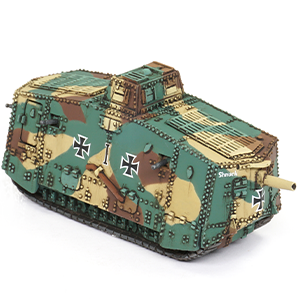 |
Painting the WWI German AV7 Tank: The Art of Enamel Washes
With Ruben Torregrosa
Acrylic paints are the most popular choice for wargamers, and in most cases, the only option on the painting bench. This preference is quite logical, as acrylic paints are readily available, non-toxic, quick-drying, and overall user-friendly. However, if we take a closer look at what Scale Modelers do, we will discover that they employ a variety of paint types, including acrylics, lacquers, oils, enamels, and powder pigments. The distinct features of each type of paint can be utilized to perform specific steps or achieve particular effects. Therefore, having an understanding of the fundamentals of all these other types of paints can help us maximize our results.
|
|
In this tutorial, we will explore how to utilize an enamel wash to emphasize all the recesses and vehicle details. Enamels and oils can be grouped together, and when compared to acrylic paints, the key distinctions lie in their use of an organic solvent like White Spirit or turpentine (making them potentially toxic) instead of water, and they require hours to dry rather than mere seconds. While these properties may not seem initially attractive, the significantly slow drying time can be a powerful advantage. It enables us to effortlessly remove excess wash and retain it only in the recesses, resulting in a cleaner outcome compared to acrylics (which can often dry with a noticeable ring), while also simultaneously creating realistic streaking effects.
|
|
Step 1: Preparation
|
|
This model features a resin hull and metal tracks and guns. Both materials are cleaned in a similar manner to remove traces of the casting process, involving the use of a modelling file and a knife. Afterwards, all the pieces are assembled using instant glue.
Before starting the painting process, it is crucial to apply a layer of primer to create a solid foundation. This step facilitates the subsequent application of paint and enhances its durability. A black undercoat is preferable because it allows us to retain shadows in the deeper areas, which will save us time in later stages. We preferably apply it using an airbrush or a simple spray can such as TITANS HOBBY: Black Matt Primer TTH100.
|
|
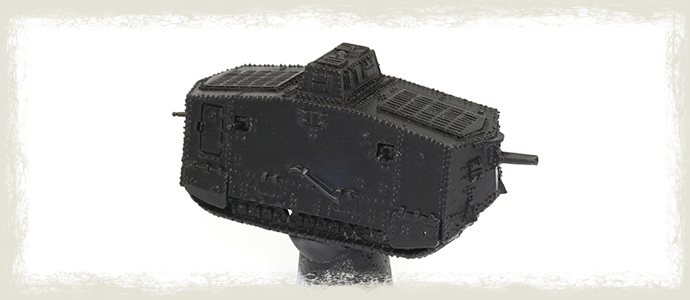
|
|
Step 2: Base Colour
|
|
After referring to online colour references, we begin by applying the base or primary colour. In this case, we've chosen a bluish-green shade, such as Dull Green A.MIG-077. This is an acrylic paint, just like all the others we will use for the camouflage. We apply at least two thin coats to get an even surface. Preferably, we use an airbrush and thin the paint with 40% Acrylic Thinner or water for optimal results. It is also possible to apply it with a brush after diluting the paint with 20% water, but caution is required to avoid masking the details.
|
|
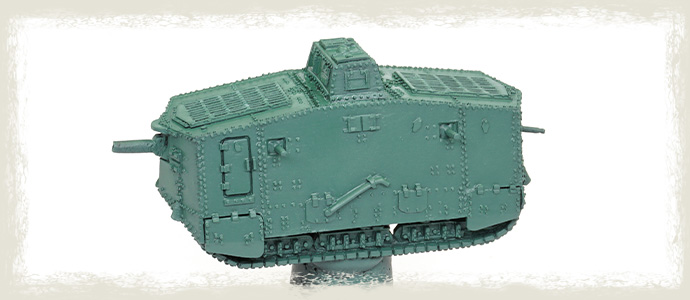
|
|
Step 3: Masks
|
|
For painting the camo spots, you can use a brush directly. However, a more efficient method involves creating a mask using self-adhesive putty and then airbrushing the paint. This method is useful when creating the so-called “hard-edge camouflages”. Accordingly, we start applying small pieces of auto-adhesive putty such as the classical Blu-Tack or products tailored for Scale Models, such as Camouflage Masking Putty A.MIG-8012. To ensure the complete adherence of the putty to the surface, we gently press it using the end of the brush handle. For the tritonal camo choice, we cover approximately 2/3 of the surface.
|
|
Step 4: First Camo Spots
|
|
Next, airbrush the first camouflage colour, like dark yellow, using Ochre Earth A.MIG-078. Apply a couple of thin layers for even coverage. If you opt for a regular brush, paint some spots with this colour, keeping in mind that a third colour -brown- will be added later.
|
|
Step 5: New Round of Masks
|
|
We repeat the masking step, covering another 1/3 of the surface carefully to avoid disturbing the previous masks.
|
|
Step 6: Second Camo Spots
|
|
Finally, the third camouflage layer is applied by airbrushing Clay Brown A.MIG-079 in thin layers onto the exposed areas. Alternatively, if using a regular brush, brown spots are painted sporadically, typically in contact with the dark yellow spots. It is recommended to have a real photo as a reference for accuracy.
|
|
Step 7: Removing Masks
|
|
This step is highly gratifying. With great care, we gradually remove the masking putty. We can use a piece of putty to gently rub the surface and remove any remaining residue.
|
|
Step 8: Fixing Spots
|
|
Occasionally, masks may shift accidentally, allowing paint to seep underneath. If necessary, we can repaint the edges of certain spots using the appropriate colours and a brush.
|
|
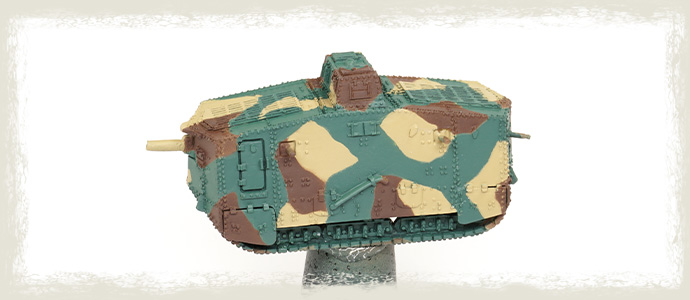
|
|
Step 9: Creating Contrast
|
|
We have not applied here any kind of shadows or highlights, and we rely on the model itself to create volume. However, this is typically not the case with such small miniatures. Adding shadows and highlights can be a time-consuming process. Alternatively, an option is to emphasize all the details, like rivets and hatches, by using lighter colours. To do this, we mix each of the previous colours with 20% of a yellowish white, such as Light Sand AMMO F-511 (compared to pure white, this colour will create warmer and more natural lights). Then, with a fine brush, we meticulously paint all the details. Sometimes we can use the body of the brush rather than the tip, for a sort of dry brushing technique to quickly paint the details, especially the rivets. This simple step allows us to add volume and achieve a significant level of definition!
|
|
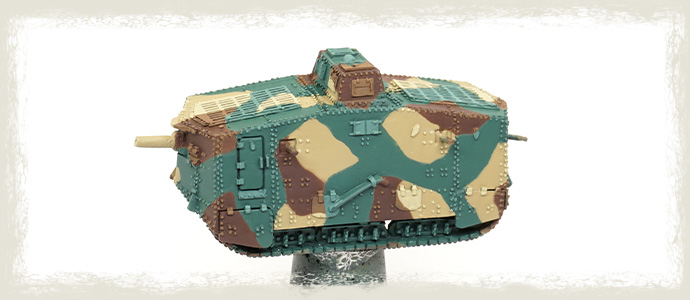
|
|
Step 10: Tracks and Accessories
|
|
Next, utilizing acrylic paints and a fine brush, we proceed to paint all the accessories of the tank. This includes the metallic components like the tracks and machine guns, the exhaust system, as well as any tools or stowage items included in the model. In this case, to achieve a rust effect on the exhaust, we use a red-brown colour like Burnt Brown Red A.MIG-0314. The tracks and machine guns are painted with a dark metallic shade, such as Gun Metal A.MIG-0045.
|
|
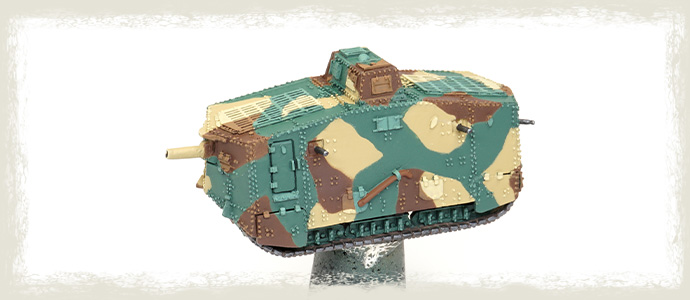
|
|
Step 11: Decals
|
|
Following real references, we apply decals to their designated positions using the appropriate products, as explained elsewhere. To achieve the best results, before applying the decals we should coat the surfaces with a thin layer of acrylic glossy varnish, such as A-STAND Aqua Gloss Clear A.MIG-2503, using an airbrush. If you do not have an airbrush, you can use a spray such as TITANS HOBBY Gloss Transparent Varnish TTH114. The glossy varnish creates a completely smooth and polished surface to ensure the best adherence of the decals.
Likewise, after the decals have been applied and have dried, we seal them with another layer of glossy varnish, which is applied over the entire vehicle. We will utilize the same feature of the glossy varnish in the next step to apply the wash, as it will readily flow and accumulate into the recesses. As we are about to apply an enamel wash, it is recommended to use an acrylic varnish. Enamel varnishes are also available, but there is a risk of inadvertently activating them when applying new enamel layers on top.
|
|
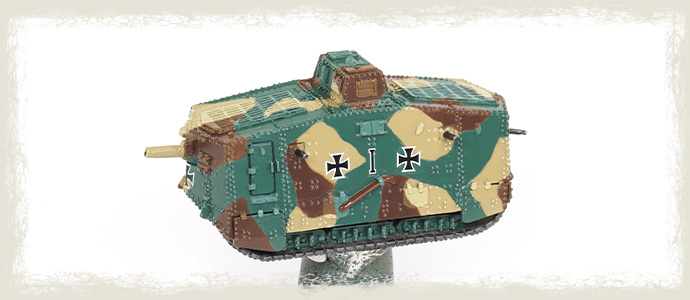
|
|
Step 12: Enamel Wash
|
|
We enhance all the recesses and details by applying a selective enamel wash, meaning that the wash is carefully applied only in the recessed areas, not over the entire surface (as is common when painting infantry models). We opt for a dark brown wash, rather than pure black, as it yields more natural results and can also be used to mimic dust or dirt. In this case, we use Dark Brown WASH for Green Vehicles A.MIG-1005, applying it with an old or synthetic brush. This is an enamel product, and accordingly, the brush is washed with an enamel thinner such as Enamel Odourless Thinner A.MIG-2019.
|
|
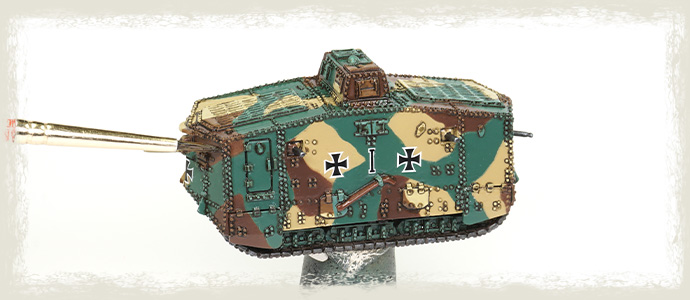
|
|
Step 13: Remove the Excess Enamel Wash
|
|
We allow the enamel wash to partially dry for 30-60 minutes (it will completely dry overnight). Once the wash is no longer very wet and has a matt appearance, we use a cotton swab or a flat brush moistened with a small amount of Enamel Odourless Thinner A.MIG-2019 to remove the excess wash. We gently rub the surface vertically, dragging the excess wash downward, while simultaneously creating streaking effects. If necessary, a fine brush can be used to delicately remove the wash from specific areas.
|
|
Step 14: Apply Matt Varnish to Seal the Job
|
|
To finish, eliminate the glossy finish and protect the paint job by applying a few thin coats of matt varnish, such as Lucky Varnish Ultra-Matt A.MIG-2054, applied with an airbrush, or alternatively, a spray can such as TITANS HOBBY Transparent Matt Varnish TTH110. With this final step, the tank will be ready for action on the battlefield.
|
|
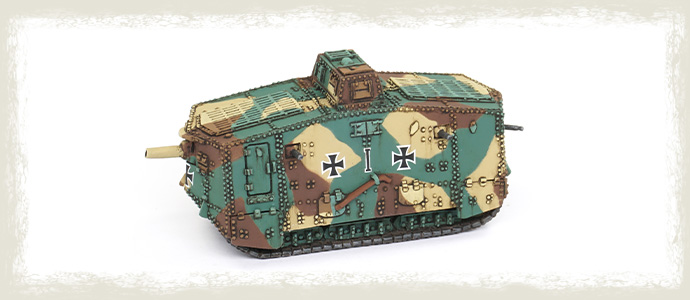
|
|
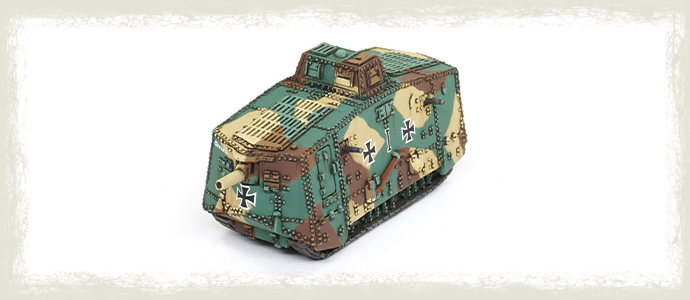
|
|
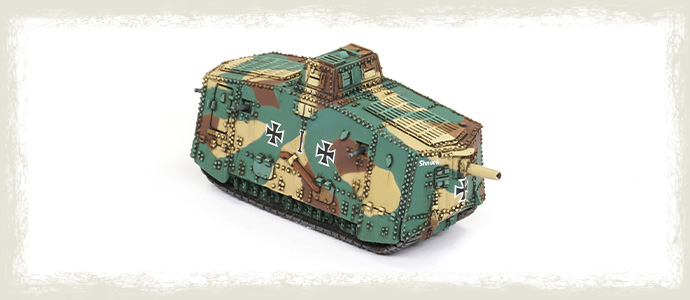
|
|
Bonus Step: Redefining and Chipping
|
|
If there is some extra time available, we can enhance the results by using a dark brown colour, such as Chipping A.MIG-044, to accomplish two goals. First, we can rectify any instances where the wash has not properly defined a detail (either due to excessive removal of the enamel wash or due to faint details) by using a fine brush. For instance, we can provide better outlines for hatches, edges, and certain rivets. Second, we can introduce chipping effects. With the brush's tip, we apply very small spots or lines here and there. We should only apply a few sporadically, especially around movable components like hatches. These chipping effects can also be used to conceal any errors from the previous steps. Additionally, we can enhance the rust effects on the exhaust by creating chips with an orange colour like Red Leather A.MIG-0133. One useful tip when painting chipping effects is to envision it as "painting a map," with shapes resembling continents or countries.
|
|
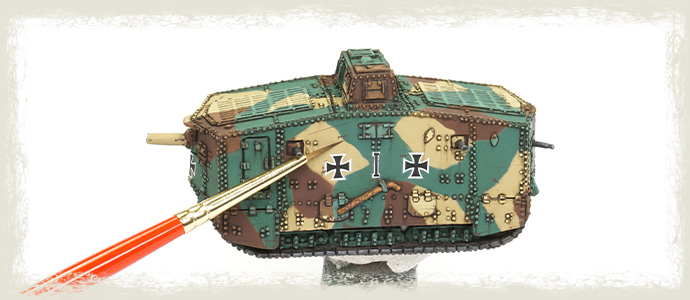
|
|
In a future tutorial, we will delve into the process of creating realistic mud effects using enamel products. Stay tuned!
~ Ruben
|
|
|